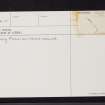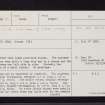Gallowhill
Bench Mark (Period Unknown), Cup Marked Stone (Prehistoric)(Possible), Stone Setting (Neolithic) - (Bronze Age)
Site Name Gallowhill
Classification Bench Mark (Period Unknown), Cup Marked Stone (Prehistoric)(Possible), Stone Setting (Neolithic) - (Bronze Age)
Alternative Name(s) Gallowhill Wood; East Gallowhill
Canmore ID 28486
Site Number NO13NE 20
NGR NO 16816 36045
Datum OSGB36 - NGR
Permalink http://canmore.org.uk/site/28486
- Council Perth And Kinross
- Parish Cargill
- Former Region Tayside
- Former District Perth And Kinross
- Former County Perthshire
NO13NE 20 1681 3604.
(NO 1681 3604) Stones (NAT)
OS 6" map (1901)
Three very large prostrate stones. The easternmost has been split a long time ago by a charge and the two pieces are left side by side. Probably the remains of a small circle. No markings.
Information from O G S Crawford 10 August 1936.
Field Visit (19 February 1969)
These stones are as described by Crawford. The southernmost, roughly triangular, measures 2.1m long x 1.8m wide x 0.6m thick. The middle stone, roughly rectangular, is 1.8m long x 1.0m wide x 0.4m thick. The 'split'stone, roughly rectangular, is 1.9m long x 1.7m wide x 0.4m thick. No other likely stones were seen in the vicinity but these three may quite well be the remains of a stone circle. Surveyed at 1/2500.
Visited by OS (WDJ) 19 February 1969.
Field Visit (18 June 1989)
These three stones are situated immediately within the SW edge of Gallowhill Wood and some 200m NNW of East Gallowhill steading; all now lie recumbent. Although previously identified as the possible remains of a stone circle, they have more probably formed at least part of an alignment orientated roughly NNE-SSW.
The northernmost stone has been split, but would have measured about 1.8m by 1.55m, and 0.5m in thickness; the central stone (2.2m to the SSW) measures 1.75m by 1.2m, and 0.4m in thickness. The third stone lies a further 4m to the SSW and beneath the modern fence-line. It measures 2m by 1.8m, and 0.8m in thickness; on its upper surface there are two possible cup-marks and an Ordnance Survey bench-mark.
Visited by RCAHMS (JRS) 18 June 1989.












